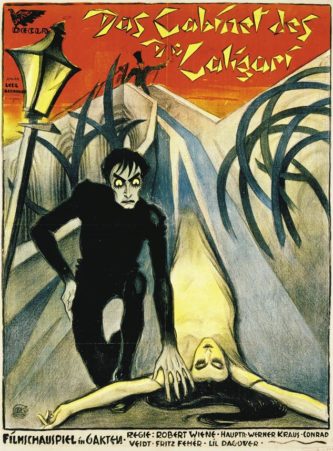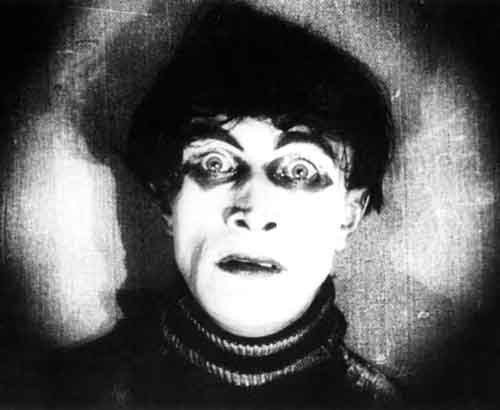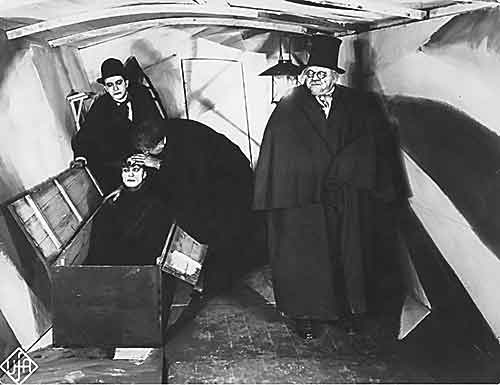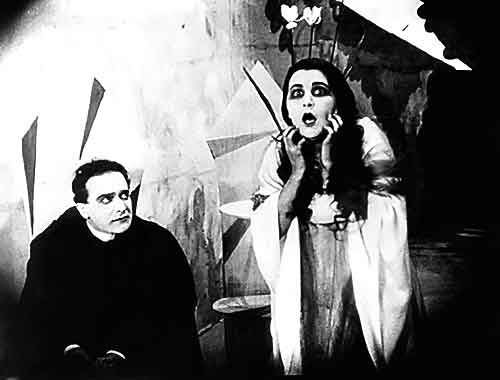 Often cited as the world’s first true horror film, this German classic from 1920 has taken on near-legendary status among cultists, and retains a loopy aura that has yet to be matched.
Often cited as the world’s first true horror film, this German classic from 1920 has taken on near-legendary status among cultists, and retains a loopy aura that has yet to be matched.
THE CABINET OF DR. CALIGARI (DAS CABINET DES DR. CALIGARI) was directed by Robert Wiene and starred Conrad Veidt. Both would go on to important careers in horror/fantasy cinema, with Wiene helming such classics as GENUINE (1920) and THE HANDS OF ORLAC (1924). Veidt was already one of the premiere horror performers of the silent era when CALIGARI was made, having appeared in films like FEAR, MADNESS and UNCANNY STORIES (all apparently lost). He’d go on to lend his presence to Paul Leni’s THE MAN WHO LAUGHS in 1927, but his career, like those of many other silent movie stars, didn’t survive the coming of sound.
THE CABINET OF THE DR. CALIGARI remains one of the most representative works of the German expressionist movement, which opposed traditional naturalism through distortion and convergence in its depiction of spiritual unrest. The film’s influence can be seen in everything from the film noirs of the 1940s to ERASERHEAD and SHUTTER ISLAND (even if you’ve never actually seen CALIGARI you’ll probably recognize its visual design). It was remade several times, most notably as the 1989 cult item DR. CALIGARI and a 2005 American-made feature with modern actors situated amid backgrounds scanned directly from those of the original film.
One day in a courtyard two apparent strangers start up a conversation. Inspired by a woman who walks by them in a trance-like state, one of the men recounts some particularly bizarre and macabre events.
It all begins at a traveling carnival, where a freaky somnambulist who dubs himself Dr. Caligari has set up a tent. His attraction is Cesare, who Caligari puts into a trance. In this state Cesare claims he can predict the future. At night Cesare sleeps in a coffin by Dr. Caligari’s side, as the latter has seemingly put Cesare into a permanent state of somnambulism.
A series of suspicious killings rock the town. The protagonist, who’s witnessed Caligari’s circus act, spends the night peering through the window of the cabinet of Dr. Caligari at the sleeping Cesare. Another murder occurs that night, but the perpetrator can’t possibly be Cesare–or can it?
The next morning the protagonist inspects the cabinet of Dr. Caligari, and finds that the sleeping figure seen the previous night is actually a dummy. The real Cesare has run off with the protagonists’ girlfriend, and Dr. Caligari has disappeared.
But there’s another, hitherto unimportant figure who now comes to the fore: the director of a local insane asylum, whose diaries reveal a lifelong obsession with the 11th Century legend of a demented somnambulist named Caligari. It seems the man grew so obsessed with the tale he actually decided he is Caligari.
But there’s still another twist in store, one that nobody could have possibly foreseen…
For the record, THE CABINET OF DR. CALIGARI is not the “first” horror movie, although it can be credited with introducing the twist ending. The twist in question justifies the film’s wildly skewed set design, intended as an externalization of the workings of an unquiet mind as much as an artistic conceit.
There are many mind-bending sights on display, including the tilted merry-go-round, the shadow killings and the visual manifestations of the insane asylum director’s madness, depicted by having the word “CALIGARI” appearing several times in lurid animation.
There’s never been another movie quite like THE CABINET OF DR. CALIGARI, even though countless others have tried to imitate it. A large part of the film’s effectiveness is due to the simple fact that it’s silent, which allows the filmmakers a degree of latitude in their creation of a hallucinatory dream world that wouldn’t be possible in a sound picture.
Vital Statistics
THE CABINET OF DR. CALIGARI
Decla-Bioscop AG
Director: Robert Wiene
Producers: Rudolf Meinert, Erich Pommer
Screenplay: Carl Mayer, Hans Janowitz
Cinematography: Willy Hameister
Cast: Conrad Veidt, Werner Krauss, Friedrich Feher, Lil Dagover, Hans Heinrich von Twardowski, Rudolf Lettinger



